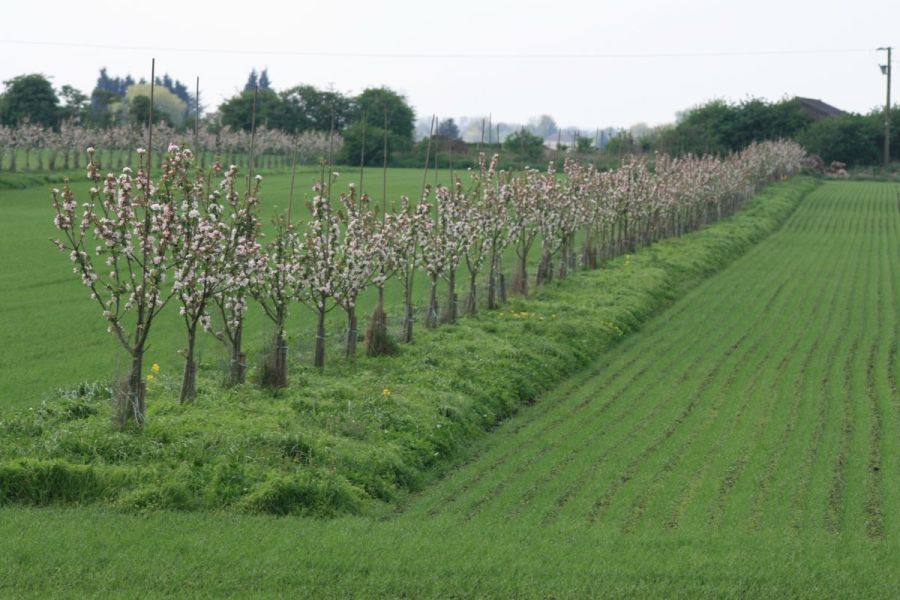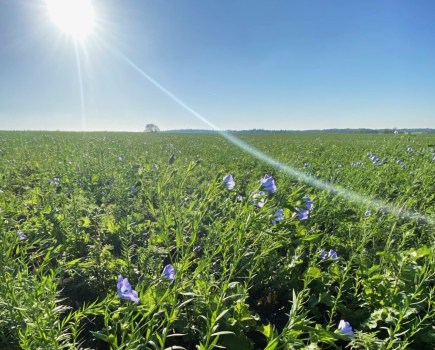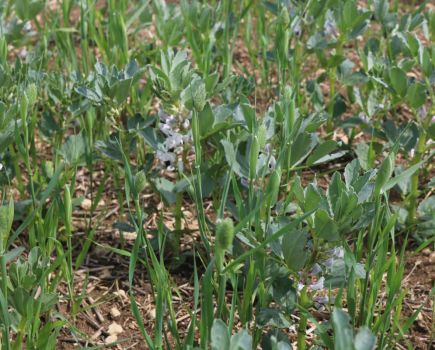With prime arable land at a premium and the human race limited to a finite planet, surely it’s impossible to create more productive outdoor space? Not according to one Cambridgeshire grower who believes it’s wholly achievable and can balance sustainability too. CPM reports.
“It’s about utilising the space above and below ground to achieve productivity gains.”
By Janine Adamson
Think maximising productive space within an upward sphere and the mind might jump to the world of controlled environment agriculture and vertical farming. However, there is an alternative that doesn’t involve complicated infrastructure and instead capitalises on a wholly natural interaction.
That being agroforestry – agriculture with trees. But whereas hedgerows, parkland and wood pasture have been features of rural landscapes for centuries, one grower believes opportunity lies in formally integrating the two – growing alleys of productive trees interspersed by arable cropping.
“I’ve made my farm bigger but in 3D,” explains Stephen Briggs, during an open day at the 113ha organic site in Peterborough. “It’s about utilising the space above and below ground to achieve productivity gains, that’s what agroforestry is about.”
So what first initiated Stephen to grow perennial and annual crops together in this way? He says it was part of a strategy to add value to the tenanted land, which back in 2007, was severely degraded from a soil perspective.
“Our fenland soils have 23% organic matter content but when we took over the tenancy I was staggered to see the level of erosion from the winds – on a ‘fen blow’ day you can see the soil disappearing over the ditch,” he explains.
“Windbreaks were an obvious solution but we also wanted to generate an income which is what inspired the silvo-arable system we’ve designed on the farm. At 52ha it’s the largest agroforestry system in the UK.”
Following in-depth conversations with Stephen’s landlord, permission was granted and the trees were planted at Whitehall Farm in 2008/9, each with a post, tree guard and mulch mat. Years later, bar the odd tree loss, the system remains in situ.
It’s based around 27m wide rows between lanes of fruit trees (mostly apple), planted at 3m spacing with a 3m pollen and nectar strip beneath. Cereal crops are grown in 24m-wide alleys and are managed through a controlled traffic farming system with 6m tramlines.
Of course, this meant investing in new 6m-wide equipment including a cultivator, drill, hoe and combine as well as a 6m Garford Robocop vision guided hoe, whereas before, the largest piece of kit was a ride-on mower, muses Stephen.
“As tenants we had to design a system which would see an economic return within the tenancy period, hence the fruit trees. We use semi-dwarf rootstock that grows to about 12ft (3.7m) which creates a microclimate, and compared with commercial orchards, we keep the trees small and pick regularly.
“Because of the spacing and good air flow we can maintain organic management without the use of fungicides.”
The farm grows around 13 different types of apple, a mix of heritage and modern varieties which yield an average of 5t/ha (harvesting 20t/year). For picking efficiency each row is a different cultivar, and pruning takes place annually in the autumn.
In terms of cereal cropping, the rotation includes gluten-free certified oats, spring and winter wheat, and spring barley, all of which are organic. Cover crops also play a role. “In conventional arable systems, crops don’t make the most of peak sunlight hours from around July to September – this is traditionally harvest time or when fields can be left bare.
“But nature figured out this conundrum a long time ago, stacking different plant species to maximise sun capture and avoid bare soil,” explains Stephen. “When you mix perennial and annual crops together, they access resources such as water, light and nutrients from different ‘spaces’ at different times during the season, ensuring you maximise farming’s most important input, sunlight.
“This is how you increase production – accessing two metres above and one metre below the surface.” But of course the question is, does this have a negative impact on the yield of the cereal crops?
To start, because the farm is organic, cereal production output is around 65-75% of a conventional system which Stephen says is offset by the improved market value and lower working capital requirements. “Our reliance on artificial inputs is also significantly reduced so we have limited dependence on third parties which minimises risk,” he says.
Stephen has then used the land equivalent ratio (LER) calculation to understand the productivity of his hectarage under the agroforestry system (relative yield of each tree and crop species), compared with if it was managed as a monoculture.
“Our calculation is 1.25 meaning we achieve more yield overall from two crops planted together than if we planted one alone. The yield advantage is 25%, so we’d require 25% more land to achieve the same yield from a monoculture. Plus remember that the trees account for just 8% of our land area whereas 92% functions as it did before.”
Although in some instances there can be an ‘edge-effect’ where crop yields are lower when adjacent to the trees rather than in the centre of the alley, Stephen has found that for crops such as oats, agroforestry encourages competitiveness resulting in the reverse.
Then, there are the wider benefits from planting trees, one of which is a reduction in N leaching, up to 50%, because trees capture N not used by the crops. Their deeper rooting systems aid drainage as well as ‘lifting’ or redistributing water to the subsoil through a process known as hydraulic lift. Because the ground is covered, evapotranspiration and soil erosion are reduced.
“The trees have helped to reduce wind velocity at ground level which minimises crop damage and the spread of fungal disease spores. As for biodiversity, we have more birds, pollinators and beneficial soil fungi in abundance. This is because we’re providing rich, varied habitats which also act as refuges for beneficial insects,” he explains.
And not neglecting the bigger picture, which According to Stephen is where trees really come into their own. “High input monoculture has its challenges such as product costs and at the same time farmers are being asked to contribute towards achieving net zero. We have to adapt to tackle climate change and I believe agroforestry can play an important role.”
This is because he says there’s nothing better than a tree to accomplish goals such as sequestering carbon from the atmosphere, building soil organic matter and soil carbon, and maximising resource capture throughout the season.
So does Stephen have insight for why agroforestry hasn’t been more widely adopted in the UK? To start, he thinks it could be a knowledge gap – farming and forestry are two completely different fields. “The people, terminology, goals and objectives are all distinct. From a basic level, it’s a case of short versus long-term management practices. Trees are in the ground for a lot longer than a cereal crop,” he says.
“It also adds complexity, although that can be managed. We’ve learned that agroforestry is do-able at a commercial scale and it can make a profit, however, people want to see it for themselves before committing.
“But you don’t have to do the whole farm at once – remember to start at an appropriate scale, learn and then expand later.”
To add even more value to the business, Stephen and his wife Lynn opened a farm shop in 2019 which now includes a deli and education centre. Whereas before the apple harvest was sent to a cider production plant, it’s now sold as fruit juice through the shop.
“Profitability remains a challenge, but it’s the same for everyone. Our local authority landlord has to increase our rent to cover budget cuts elsewhere, but our margins haven’t increased at the same rate,” comments Stephen.
“For others perhaps there’s the potential to share a business model such as ours and combine enterprises, so different individuals manage the trees, cereal crops and so on. We’d love to integrate poultry but our tenancy doesn’t permit it. Ultimately, we just want to add value to our small farm,” he concludes.
The open day at Whitehall Farm was organised as part of the Farm of the Future event series from Innovation for Agriculture (IfA) and RASE. The charity has organised two study tours for November which are taking place in Lincolnshire and Herefordshire. Visit www.i4agri.org/events for further information.
This article was taken from the latest issue of CPM. Read the article in full here.
For more articles like this, subscribe here.
Sign up for Crop Production Magazine’s FREE e-newsletter here.




